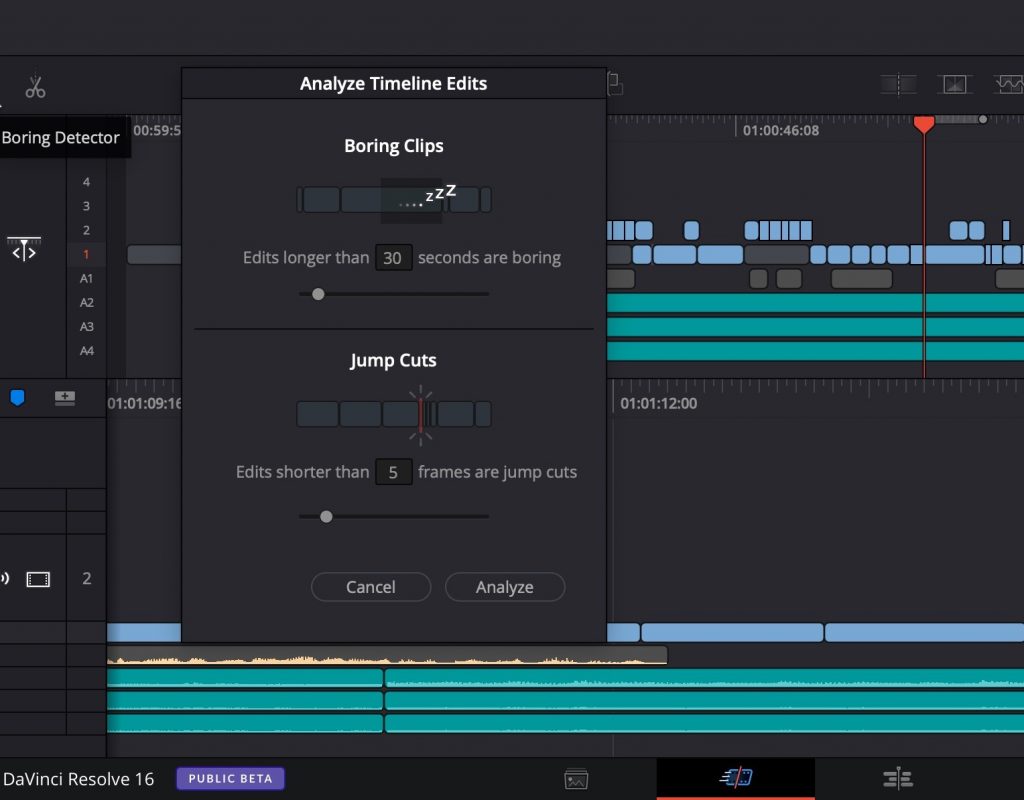I was working on Thursday when Blackmagic Design’s Grant Petty introduced a batch of new products in a live stream. These types of events are becoming regular things with BMD and it’s a great way to get the information out to a lot of people. Since I was working I was only casually listening but I had to do a double-take when I heard him talk about the “boring detector” in the newest beta of Resolve 16.
What the what? A boring detector? Really? My first reaction was this:
OMG did @Blackmagic_News just say they added a “boring detector” to #Resolve16 ?
THE EDITOR (and maybe the client) will determine what is boring.
IT’s actually just checking shot durations which might come in handy but. ….. boring detector? Really?
— Scott Simmons (@editblog) August 8, 2019
Before editors everywhere are insulted at the notion that the software knows what is boring better than they do it’s important to take a look at what the “boring detector” actually does and you can do that by just taking a look at the “boring detector” dialog box.
This new tool is nothing more really than a frame counter that is analyzing your shots based on a frame count. It’s looking for shots that could be either too long (hence, being boring) or too short. I’ve seen this new “boring detector” described as a good use of AI in an NLE but it seems to me it’s just counting frames and not artificially intelligently analyzing anything. Long shots and jump cuts can both be legitimate issues you might want to flag in your cut but depending on the creative intent the shots might be neither boring or jump cuts.
The “boring detector” still has me chuckling just as a concept and framing, even if I can think of a dozen jobs where I would absolutely have used it. Lots of corporate stuff that’s really mechanical anyway.
— Dan Olson (me) (@FoldableHuman) August 8, 2019
What is the creative intent of the edit?
The thing is, I have no problem with the feature itself.. definitely, not gonna use it, but I understand who is it for. But calling it the “boring detector” and saying that editors won’t have to watch their video is just encouraging misconceptions and bad practices
— Abdelrahman M. Said (@AR_MSaid) August 9, 2019
Whenever you’re looking at something as easy and simple as frame counts and trying to derive something as subjective and complex as emotion and creative intent you’re bound to insult the editors and directors out there when you call it a “boring detector.” I’m sure this wasn’t what BMD set out to do when they created a truly useful tool for editors but it’s what they did.
Would Resolve 16 think the legendary Goodfellas tracking shot was boring?
What about the 30-second “refusal” scene in Philadelphia? That’s a shot that still haunts me to this day but I guess the Resolve “boring detector” wouldn’t have flagged that one as it’s set to 45 seconds by default.
And then there’s Rope or the entirety of Russian Ark.
Luckily…Stanley Kubrick has 3 films that the new “Boring Detector” will not flag as having boring edits.#phew pic.twitter.com/dzUmh4FdzV
— Vashi Nedomansky, ACE (@vashikoo) August 9, 2019
I realize it is a bit of a stretch to compare some shots from great cinema to what feels like an editing feature that was added to another editing feature that may very well have been created to placate an era of low budgets with fast turnarounds and YouTubers but if Resolve wants to make in-roads in ALL areas of media post-production serious, creative offline storytelling is one of them. I saw a number of high-end feature editoral professionals talking about this thing on social media.
Obviously, a piece of software counting frames is never going to know the creative intent of why a shot was chosen by the editor (and sometimes director) to last as long as it does. While it may seem like long shots make the life easy for an editor there is, in reality, a lot of time and work that goes into the decision to even include a long shot in an edit.
- How long do you hold it?
- At what point do you cut (or transition) away from the shot?
- Where to go next?
- And what is perhaps the biggest question of all … what is happening in the frame during that shot to make sure it isn’t boring?
It’s those reasons that the naming of a tool inside of a video editing application a “boring detector” caused such offense to editors everywhere. I doubt there was much discussion inside of BMD about how such a name would cause a stir. Then again, maybe that was BMD’s creative intent when they named it.

